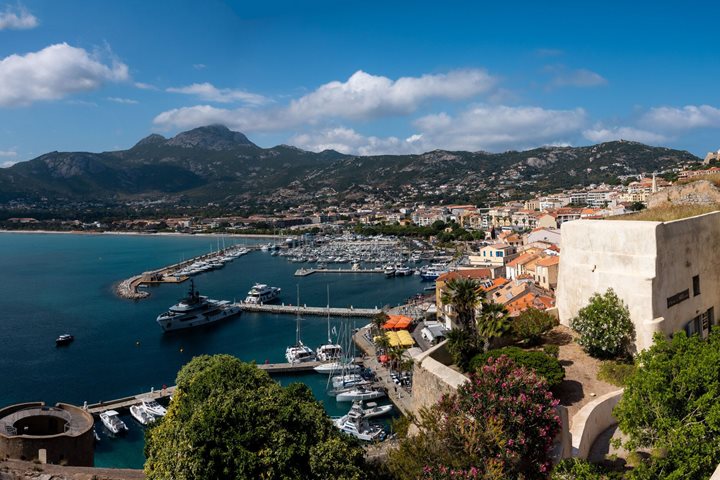The sun was up by 6:04AM and the sea was glass calm, barely showing a ripple. We had a stern wind of 10 knots from the east southeast. We have now rounded the northern tip of Corsica, called Cap Corse. By breakfast time, the temperature was in the mid-60’s with a wind now from the starboard. The captain called the sailors to their stations at 9:00AM. The sails set and we had a gentle wind moving us at about 2 knots, but by 10AM we were doing 5.7 knots. The captain called for the sails to be furled at 11:30AM.
The powerful and rich city state of Genoa controlled this region of Corsica for five centuries. The Genovese knew that Cap Corse was a very vulnerable spot and so they built coastal watch towers that dotted the coast. Raids were common and pirates could and did swoop in to pillage the land and the wealth of the churches, held hostages for ransom, and sold inhabitants into slavery. There was a substantial market for European slaves in the Ottoman Empire. Prior to the emergence of alliances amongst the powerful nations, for example, like a modern-day NATO, city states like Genoa, Pisa, Venice, although very rich, competed amongst themselves and had difficulty protecting their far-flung possessions.
At a few minutes after 10AM, historian Tom Heffernan gave a lecture on how the Black Death of 1347 created conditions for a new Europe. He drew comparisons with how Covid had made some substantive changes in the present. We took on the pilot about noon and motored into Bastia harbor.
After lunch we left the Sea Cloud for a walk through historic Bastia. Some of us chose to take a beautiful coach ride through the peninsula. Those of us who stayed for the city tour, began by crossing the central park. Our guide was the very ebullient Aida. There she showed us a bronze statue of a woman and her son looking to the distance, commemorating the Corsican war dead who fought to liberate Corsica and France during the last world wars.
Napoleon is still held in high regard by Corsicans – despite their zeal for autonomy and his passion for tyrannical centralized control – as the famous son who ruled the world. His statue in the plaza depicting him as a Roman leader is impressive. On our way to the citadel, we admired a house whose windows and shutters were trompe d’oeil. We made brief visits to two beautiful baroque churches. Some folks are puzzled by why church visits are always part of our tour. But consider, the church was the center of the community. It was the fulcrum around which the community functioned. It was also one of the wealthiest units in the town and was the recipient of lots of philanthropy in the form of great paintings, liturgical works in gold, and silver, sculpture, frescoes, etc. The church was also the creator of technologies as building large cathedrals and churches created innovation in engineering skills and in 100 different artisanal disciplines. In other words, the church is a microcosm of the historical changes the cities we have visited went through.
Our last stop was the citadel. The citadel is distinctly Genovese in architecture and, in the 16th century, only the Italians were allowed to live there. The Corsicans lived below. The beautiful cathedral of the Immaculate Conception contained a spectacular painted ceiling and superb arches. The church held a solid silver statue of the Annunciation weighing 750 kilos (1800 pounds). The Genovese community had money; remember they controlled the trade with the east. On our way down from the citadel, a clap of thunder echoed in the heavens and a deluge poured down on us. The drops were massive and the streets were a torrent of water but we soldiered on. We completed the day with a scrumptious dinner.







